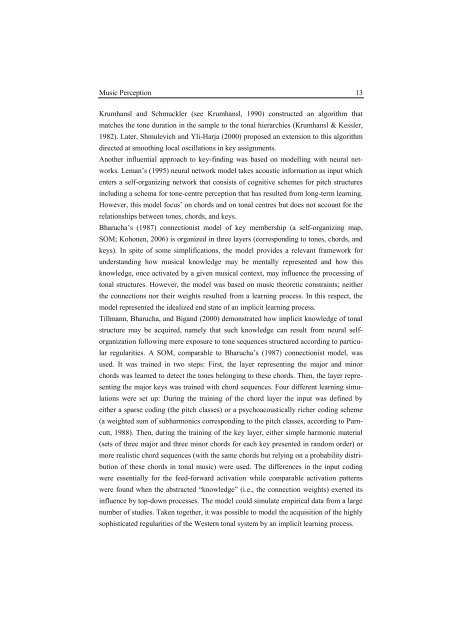Neural Correlates of Processing Syntax in Music and ... - PubMan
Neural Correlates of Processing Syntax in Music and ... - PubMan
Neural Correlates of Processing Syntax in Music and ... - PubMan
Create successful ePaper yourself
Turn your PDF publications into a flip-book with our unique Google optimized e-Paper software.
<strong>Music</strong> Perception 13<br />
Krumhansl <strong>and</strong> Schmuckler (see Krumhansl, 1990) constructed an algorithm that<br />
matches the tone duration <strong>in</strong> the sample to the tonal hierarchies (Krumhansl & Kessler,<br />
1982). Later, Shmulevich <strong>and</strong> Yli-Harja (2000) proposed an extension to this algorithm<br />
directed at smooth<strong>in</strong>g local oscillations <strong>in</strong> key assignments.<br />
Another <strong>in</strong>fluential approach to key-f<strong>in</strong>d<strong>in</strong>g was based on modell<strong>in</strong>g with neural networks.<br />
Leman’s (1995) neural network model takes acoustic <strong>in</strong>formation as <strong>in</strong>put which<br />
enters a self-organiz<strong>in</strong>g network that consists <strong>of</strong> cognitive schemes for pitch structures<br />
<strong>in</strong>clud<strong>in</strong>g a schema for tone-centre perception that has resulted from long-term learn<strong>in</strong>g.<br />
However, this model focus’ on chords <strong>and</strong> on tonal centres but does not account for the<br />
relationships between tones, chords, <strong>and</strong> keys.<br />
Bharucha’s (1987) connectionist model <strong>of</strong> key membership (a self-organiz<strong>in</strong>g map,<br />
SOM; Kohonen, 2006) is organized <strong>in</strong> three layers (correspond<strong>in</strong>g to tones, chords, <strong>and</strong><br />
keys). In spite <strong>of</strong> some simplifications, the model provides a relevant framework for<br />
underst<strong>and</strong><strong>in</strong>g how musical knowledge may be mentally represented <strong>and</strong> how this<br />
knowledge, once activated by a given musical context, may <strong>in</strong>fluence the process<strong>in</strong>g <strong>of</strong><br />
tonal structures. However, the model was based on music theoretic constra<strong>in</strong>ts; neither<br />
the connections nor their weights resulted from a learn<strong>in</strong>g process. In this respect, the<br />
model represented the idealized end state <strong>of</strong> an implicit learn<strong>in</strong>g process.<br />
Tillmann, Bharucha, <strong>and</strong> Big<strong>and</strong> (2000) demonstrated how implicit knowledge <strong>of</strong> tonal<br />
structure may be acquired, namely that such knowledge can result from neural selforganization<br />
follow<strong>in</strong>g mere exposure to tone sequences structured accord<strong>in</strong>g to particular<br />
regularities. A SOM, comparable to Bharucha’s (1987) connectionist model, was<br />
used. It was tra<strong>in</strong>ed <strong>in</strong> two steps: First, the layer represent<strong>in</strong>g the major <strong>and</strong> m<strong>in</strong>or<br />
chords was learned to detect the tones belong<strong>in</strong>g to these chords. Then, the layer represent<strong>in</strong>g<br />
the major keys was tra<strong>in</strong>ed with chord sequences. Four different learn<strong>in</strong>g simulations<br />
were set up: Dur<strong>in</strong>g the tra<strong>in</strong><strong>in</strong>g <strong>of</strong> the chord layer the <strong>in</strong>put was def<strong>in</strong>ed by<br />
either a sparse cod<strong>in</strong>g (the pitch classes) or a psychoacoustically richer cod<strong>in</strong>g scheme<br />
(a weighted sum <strong>of</strong> subharmonics correspond<strong>in</strong>g to the pitch classes, accord<strong>in</strong>g to Parncutt,<br />
1988). Then, dur<strong>in</strong>g the tra<strong>in</strong><strong>in</strong>g <strong>of</strong> the key layer, either simple harmonic material<br />
(sets <strong>of</strong> three major <strong>and</strong> three m<strong>in</strong>or chords for each key presented <strong>in</strong> r<strong>and</strong>om order) or<br />
more realistic chord sequences (with the same chords but rely<strong>in</strong>g on a probability distribution<br />
<strong>of</strong> these chords <strong>in</strong> tonal music) were used. The differences <strong>in</strong> the <strong>in</strong>put cod<strong>in</strong>g<br />
were essentially for the feed-forward activation while comparable activation patterns<br />
were found when the abstracted “knowledge” (i.e., the connection weights) exerted its<br />
<strong>in</strong>fluence by top-down processes. The model could simulate empirical data from a large<br />
number <strong>of</strong> studies. Taken together, it was possible to model the acquisition <strong>of</strong> the highly<br />
sophisticated regularities <strong>of</strong> the Western tonal system by an implicit learn<strong>in</strong>g process.












